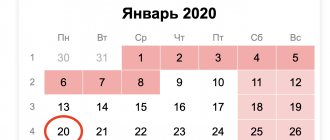Who submits information
The average headcount is a specially calculated element that reflects the average number of employees working in a business entity in a particular time period.
This value is required to be calculated by every business entity that has hired employees. The time period for calculation, depending on the need, can be chosen in any way - month, quarter, half-year, year, etc.
But even when calculating different time periods, the technology for obtaining the indicator does not change.
In 2014, a relaxation was made for entrepreneurs - they now do not have to document information about the average number of employees if they carry out the work independently, without hiring third-party workers.
Attention: one of the important areas of application of the obtained element is the division of business entities into groups based on the number of employees involved.
And this, in turn, will determine the possibility of using one or another tax preferential regime. Also, the payroll number is used to determine the average salary for the organization. The period of storage of the report in the archive of a business entity is 5 years.
Which employees are counted?
The payroll includes all employees with whom an employment contract has been concluded and who perform permanent, temporary or seasonal work, with the exception of external part-time workers.
The payroll also takes into account those absent from work (business travelers, sick people, those sent for off-duty training, those on vacation, absenteeism, etc.).
Categories of those who are not included in the payroll: external part-time workers, persons performing work under civil contracts, those who submitted a letter of resignation and stopped working without warning, lawyers.
When calculating the average headcount, the following are not taken into account:
- women on maternity leave
- persons on leave in connection with the adoption of a newborn child from a maternity hospital, as well as on additional leave to care for a child
- workers studying and entering educational institutions who are on additional leave without pay.
Deadlines for submitting a report on the average headcount in 2020
The day by which a business entity is obliged to provide regulatory authorities with a report on the average headcount depends on the functioning of the entity itself:
- Individual entrepreneurs and companies that have been operating for a long time are required to submit a report by January 20 of the year that follows the year of the report. If such a day falls on a weekend or holiday, then the deadline is moved forward to the first working day. In 2020, January 20 is a Sunday, so the report will need to be submitted by January 21, 2019.
- The average headcount for newly created organizations must be submitted by the 20th day of the month following the month the company was created. The second time you open an LLC, you will need to send a report on schedule, at the end of the calendar year. Thus, for a newly created LLC, two dates have been determined on which a report will need to be filed in the first year of its existence.
- If an individual entrepreneur or company is closed, then the final report must be submitted on the day the business entity is removed from the state register.
Length of working day in hours
| Number of working hours per week | Length of working day with a 5-day working week | Length of working day with a 6-day working week |
| 40 | 8 (40 hours: 5 days) | 6.67 (40 hours: 6 days) |
| 36 | 7.2 (36 hours: 5 days) | 6 (36 hours: 6 days) |
| 24 | 4.8 (24 hours: 5 days) | 4 (24 hours: 6 days) |
Once the number of man-days has been determined, you can calculate the average number of part-time workers:
Average number of part-time employees = Total number of man-days worked by all part-time employees: Number of working days in a month
Where are reports submitted?
The law states that a company must submit a report on average headcount to the Federal Tax Service located at its location. If a company has branches or separate divisions, all information is compiled into a single report, which is submitted by the parent company.
Individual entrepreneurs who have employees must send a report to the address of their registration or actual residence.
Attention: if an individual entrepreneur is registered in one subject and conducts activities in another, he must still submit a headcount report to the Federal Tax Service at his registered address.
Methods for submitting information
This form can be submitted both in paper and electronic form; there are several ways to submit it:
- You can submit the completed report on paper personally to the inspector, or through an authorized representative with a power of attorney. The form must be drawn up in two copies, one will remain with the Federal Tax Service, and the second with a mark of receipt will be returned back to the business entity;
- Sending by mail in an envelope using a registered letter;
- Via the Internet, using EDI services. In this case, the file itself must be signed with a qualified signature.
Attention: in some regions, when submitting a report on paper, you also need to provide a file on a flash drive or other media. Before visiting a government agency, it is recommended to call and clarify this need.
How to report
Information is submitted in a form approved by order of the Federal Tax Service of Russia dated March 29, 2007 No. MM-3-25/ [email protected] Recommendations on how to fill it out are given in the letter of the Federal Tax Service of Russia dated April 26, 2007 No. ChD-6-25/ [email protected] ] The form itself consists of one sheet. At the top indicate the TIN of the organization or individual entrepreneur and the checkpoint of the organization. The line “Submitted in ____” is intended for the name and code of the inspection. Below you should provide the full name of the organization in accordance with the constituent documents or the full name of the entrepreneur.
The average number is indicated in whole units. A fractional number is rounded according to the general rule: numbers after the decimal point from 5 or more are rounded up to a whole number, and numbers 1-4 are discarded. The form is signed by the head of the company, individual entrepreneur or representative, stamped and dated. In this case, the full name of the manager or representative is indicated.
The deadline for submitting information on the average number of employees for the previous calendar year, as we mentioned at the beginning of the article, is no later than January 20 of the current year. That is, the deadline for submitting information on employees for 2020 is January 20, 2020. These are the requirements of paragraph 3 of Article 80 of the Tax Code of the Russian Federation.
Please note: if a company submits information about the average headcount late, the tax office may impose two fines at the same time. For organization - in the amount of 200 rubles. and for its manager - in the amount of 300 to 500 rubles. (clause 1 of article 126 of the Tax Code of the Russian Federation, clause 1 of article 15.6 of the Code of Administrative Offenses of the Russian Federation, letter of the Ministry of Finance of Russia dated 06/07/2011 No. 03-02-07/1-179).
An entrepreneur who is late to submit information on employees will pay 200 rubles. (clause 1 of article 126 of the Tax Code of the Russian Federation).
How to fill out a report on KND form 1110018
The KND form 1110018 is not very difficult to fill out. But before doing this, you need to determine the value of the average number according to the list.
At the top of the form are the TIN and KPP codes, and next to it is the sheet number. It will always be 001. It must be remembered that if the form is filled out by a company, it will have two empty cells in the TIN field that you just need to cross out. If the report is prepared by an individual entrepreneur, then it will not have a checkpoint code, which is also completely crossed out.
At the next stage, the Federal Tax Service enters into the document, where the form is sent - first this must be done in words, and then the code must be entered in numbers.
Next, the full designation of the organization or full name is entered into the form. IP. This information is recorded without abbreviations, as it appears in the registration documents.
The next step is to enter the date as of which the information is provided:
- In the case when a planned annual report is drawn up, January 1 of the current year is entered here.
- If the report is submitted due to the creation of a business entity or its closure, then here you need to indicate the 1st day of the month following the month of this event.
On the next line there is a field in which you need to enter the number. It is filled in from left to right; if any cells are left empty, they must be crossed out.
The lower part of the report is divided into two parts; the business entity needs to fill out only the left column.
Filling out depends on who provides the completed form:
- The director himself puts down his full name, the date of submission of the document and endorses it with his personal signature;
- The entrepreneur must indicate the date of delivery and endorse it with a signature;
- If the report is submitted by proxy, you must indicate the full name of the proxy or the name of the company. The delivery date is also indicated and everything is endorsed with a signature. In the bottom column you must enter information about the executed power of attorney. The power of attorney form itself is attached to the form as an attachment.
Calculation example
was registered on October 15, 2020 and has applied a simplified taxation system since its inception. The organization has a 40-hour, five-day work week (the working day is 8 hours). The list number of employees working under a full-time employment contract was:
- from October 15 to November 20 - 18 people
- from November 20 to December 31 - 23 people
Part-time employees were absent during October and November 2020. And on December 1, an assistant accountant was hired on short-time working hours. In December, he worked 4 hours for 23 days.
Based on the results of 2020, we will calculate the average number of employees of Eclair LLC as follows.
- The monthly average number of full-time employees is: - in October - 9.87 people. (18 people × 17 days: 31 days) - in November - 19.66 people. (18 people × 20 days + 23 people × 10 days) : 30 days — in December — 23 people. (23 people × 31 days: 31 days)
- The monthly average number of employees who have a part-time work schedule is: - in December - 0.5 people. (4 person-hours × 23 days: 8 hours: 23 days).
- The monthly average number of all employees is: - in October - 9.87 people. — in November — 19.66 people. — in December — 23.5 people. (23 people + 0.5 people).
- The average number of employees for 2020 is 4.42 people. (9.87 people + 19.66 people + 23.5 people): 12.
How to calculate the average number of employees
Such calculations at an enterprise are usually carried out by an accountant or personnel officer.
Since this indicator is of great importance for the organization’s activities, its calculation must be approached with all responsibility, since high accuracy of its determination must be maintained.
Indeed, based on the results obtained, the possibility of using a preferential tax regime can be determined for the company. Also, the supervisory authority has the right to double-check the correctness of the calculation at any time.
Data for calculating the indicator are selected from time recording documents, orders for hiring, dismissal of employees and other similar forms.
Most accounting computer programs calculate the indicator automatically, based on the data entered into them. But even in this case, it is recommended to double-check the calculation, as well as the sources of information.
The employee must understand the process of calculating the indicator in order to check it at any stage.
Step 1. Calculation of the number of employees on each day of the month
At this step, you need to determine the number of employees who had valid employment agreements with the business entity on each day of the month. This number necessarily includes employees who are sick that day, are on vacation, or go on a business trip.
The following people are also excluded from the calculation:
- If they work as part-time workers (they are counted at their main place of work);
- Performing work under civil contracts;
- Employees who are on maternity leave or caring for children under 3 years of age;
- Employees who work shorter hours under an employment contract. At the same time, if this condition is established due to legal restrictions, then it is necessary to take them into account.
On weekends and holidays of the month, it is necessary to hire the same number of workers as they were on the previous working day. Several nuances emerge from this - if an employee quits on Friday, then in the headcount calculation he will still be included on Saturday and Sunday.
Attention: if the company does not have a single hired employee, but has an appointed director (even if he is not paid a salary and no deductions are made), the number of 1 person is indicated for each day of the month.
Step 2. Determination of the monthly average number of full-time workers
At this step, the number of employees on each day of the month who work the whole working day is determined. This number is then divided by the number of calendar days in the calculation month.
SSCHpol =(NUM1+NUMBER2+…+NUMBER31)/DAYSmonth, where
SSChpo l is the average number of full-time workers per month;
NUM1, NUM2, NUM3 is the number of full-time employees for each calendar day of the month;
DAYS month - the number of days according to the calendar in the month of calculation.
The resulting indicator must be rounded according to mathematical rules to the hundredth place.
Calculation example. There are 31 calendar days in July 2020. From the 1st to the 14th, the company employed 38 people, from the 15th to the 22nd - 37 people, from the 23rd to the 31st - 41 people. Let's determine the number.
The average number of full-time employees is:
(14x38+8x37+9x41)/31 = 38.61 people.
Step 3. Determination of the monthly average number of part-time workers
To calculate this indicator, you need to determine the total number of hours that part-time employees worked during the month. If one of them had a period of vacation or illness in the month of calculation, then the number of hours for these days is set according to the previous working day.
After the number of hours is determined, the headcount is directly calculated. To calculate it, you need to divide the sum of hours worked by the product of the number of working days in a month and the standard working hours for a full day of work.
SShour = HOUR/NORDn*NORhour, where
SSChh is the average number of part-time workers per month,
CHAShz - the number of hours that part-time employees worked in total,
NORDn - number of working days in a month
NORhour is the fixed standard duration of the working day. If a company works on a 40-hour week, then its value is 8 hours; with a 32-hour week, it is 7.2 hours.
The result must also be rounded to the nearest hundredth.
Calculation example. In July, part-time workers worked a total of 242 hours. The company operates on a 40-hour workweek, with 22 working days in July.
Number calculation: 242/(8*22)=1.38 people.
Step 4. Determining the average monthly number of all employees
This indicator is obtained by adding the previously obtained number of full-time and part-time employees.
The following formula is used for calculation:
SSChmonth = SSChpol + SSChhour, where
SSChmes - total average number for the month;
SSchpol - monthly number of employees working full time;
RSShour is the monthly number of employees working part-time.
The final result must be rounded to a whole number according to the requirements of mathematics. This means that a total less than 0.5 is discarded, and a total greater than this value is rounded forward to 1.
Calculation example. Using the previously obtained values, we find the number for the month:
38,61+1,38=39,99
This value should be rounded to 40.
Step 5. Calculation of the annual average number of employees
To determine this indicator for the year, you need to take the calculated values of the average headcount for monthly periods. When calculating this indicator, it is necessary to add up all the monthly values of the average headcount and divide the resulting result by the number of months - by 12.
SSChg =(SSChya+SSChf+…+SSChd)/12, where
SSChg is an indicator of the average number of employees for the year under review.
SSChya , SSChf , etc. – average number of employees for January, February, March, etc.
The average headcount indicator should not include fractional numbers, therefore, according to the rules of mathematics, it must be rounded after calculation.
The legislation provides for the specifics of determining the average headcount for enterprises registered in the current year.
Attention: the peculiarity of this method assumes that for the calculation it is necessary to summarize the indicators of the average headcount only from the moment the company was opened. However, the denominator of the formula still needs to include the number of months – 12. This value is not adjusted taking into account the period of the organization’s activities.
The average headcount indicator is also used in interim reporting, which is presented for a quarter, half a year, and 9 months. To determine these values, the formula discussed above can be used.
Only the data is taken for the required number of months, and in the denominator it is necessary to set a figure corresponding to each calculation period. For example, for quarterly headcount - 3, half-yearly - 6, 9 months - 9.
Who's left out
№ pp
| Category of persons | |
| 1 | External part-timers |
| 2 | Citizens performing work under civil contracts |
| 3 | Owners of the organization itself who do not receive wages |
| 4 | Employees on maternity leave or parental leave |
| 5 | Those who enroll to study and are on leave without pay to take entrance exams |
| 6 | Those who are transferred to work in other organizations, if their wages are not maintained, and are also sent to work abroad |
| 7 | Persons sent by the company to study in educational institutions outside of work and receiving a scholarship at its expense |
| 8 | Citizens who submitted a letter of resignation and stopped working before the expiration of the notice period or stopped working without warning the employer |
| 9 | Persons with whom an apprenticeship agreement has been concluded with only stipends paid during the apprenticeship period |
| 10 | Employees on unpaid study leave |
To determine the average number of part-time workers, you need to find out the total number of man-days worked by these workers. The indicator for each employee is calculated as follows:
Number of man-days worked by a part-time employee = Number of hours worked by a part-time employee : Standard working hours
The resulting number of man-days worked by the employee must be multiplied by the number of days worked in the month.
The standard length of the working day depends on the accepted number of working hours per week. This follows from paragraph 81.3 of the Guidelines. For convenience, we present the indicators in table. 2 below. For example, with a five-day work week with a total duration of 40 hours, man-hours should be divided by 8.







